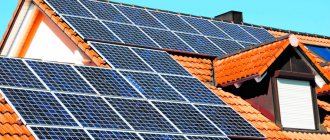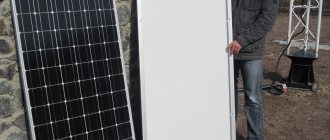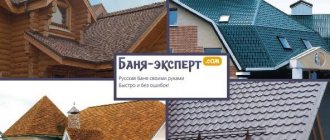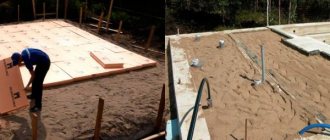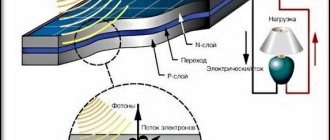Until recently, roofing tiles were intended only to protect the roof and as an advantageous design for the house for its beautiful appearance. But installing solar tiles completely changes the entire concept of the importance of tiles, making their use even more necessary when building a house using environmentally friendly technologies. Roof tiles with photovoltaic elements will allow you to save energy in your home over the long term, and, in addition, will improve the appearance of any modern building.
Photovoltaic roof tiles
Every time the phrase “alternative solar energy” is heard, a picture of a large solar panel installed on the roof appears in my head. Until recently, many people avoided installing bulky structures with solar panels on their roofs, since they did not fit into the overall design of the building and spoiled the entire appearance of the house. Now every inhabitant of our planet, when building a country cottage, can use specially designed “solar” tiles, or as it is commonly called among builders, “photovoltaic” tiles, without compromising the appearance of the roof and the entire house as a whole.
Unlike older designs, “solar” tiles are not only cheaper than solar panels and easy to install, but also completely replicate the design of conventional roofing tiles. Its main functions lie in two main points - protecting the roof structure and producing cheap electricity by using solar energy for the household needs of the residents of the house.
Photovoltaic cells are included in the structure of the tile itself, so it looks like a regular flexible structure and is no different in appearance from other types of roofing tiles. It is perfectly fixed during installation and tolerates all changes in weather conditions well; its fastening design is capable of withstanding hurricane wind gusts of up to 130 km per hour.
Solar panels on the roof
Sources of alternative electricity generation are becoming increasingly important. Once upon a time, obtaining solar energy seemed fantastic, but now such batteries are widely used both in astronautics and in the construction of private houses.
The photo shows solar panels placed on the roof
The most widespread installation of solar panels has been in areas where there are quite a lot of sunny days a year. In our country, the use of this type of energy source has begun to gain momentum no less than in European countries, where the development of solar energy began. Read about what types of composite tiles exist on this page.
The basis of a solar battery is:
- A semiconductor type photogenerator that converts solar energy into current;
- An invector, through which the current will be converted into alternating current. This is the current used for electrical appliances;
- A controller necessary to monitor the normalization of charge for battery operation.
The design of this device is quite simple, but it has a large number of advantages:
- The energy source is free and inexhaustible (depending on the amount of sunlight);
- Do not harm the environment;
- Maintenance only includes cleaning the battery panels from accumulated dust;
- You can receive electricity in places where there are no centralized networks;
- Possibility of combining the operation of solar panels and other electrical equipment.
That is, as long as there is a lot of sunlight, you can use an alternative source of electricity, and if there is quite a bit of sunlight, a regular power source is connected; - It pays for itself quite quickly, compared to the fact that electricity prices regularly increase.
Like any other devices, solar panels also have their disadvantages:
- Quite a high price for equipment;
- The efficiency is not very high;
- There is a direct dependence on sunlight.
When equipped with solar panels on the southern slope of the roof, production can reach 300 kilowatts (per month). Read about the technology of installing sandwich panels on this page.
Solar panels on the roof of a private house
There are 2 installation options:
- Roof alteration;
- Replacing part of the coating with photocells (such parts resemble tiles).
Quite a large number of people believe that such a structure on the roof of a private house is too bulky, which, in addition, must be difficult to install. However, this is not true.
There is and is quite widely used this type of solar panels, which after installation look exactly like tiles. This type of product is almost 2 times cheaper than standard solar panels, and their efficiency is almost 10% higher.
In this image, solar panels replace the roof's roof.
The bottom line is that the photocell is built into a special form and mounted on the roof. Ultimately, roofing work using this technology is practically no different from standard ones.
The advantages include:
- Cost savings up to 50%;
- The appearance of the roof does not change.
In Russia, devices using this technology are also quite successfully manufactured. Everything will depend on the individual needs of the homeowners. When choosing solar panels, you should not save money, since even expensive devices, taking into account advanced technologies, pay for themselves quickly enough.
There is no need to worry about not having enough sunlight to generate energy. Solar panels for a private home have proven themselves quite well in cloudy weather. However, the leading direction for installation is the south side of the roof.
There are times when the structure of the building itself will not allow the batteries to be oriented in the correct direction. Don't worry. It is only necessary to install a number of additional fasteners. Read about existing materials for attic insulation here: https://fineroofs.com/uteplenie-kryshi/materialy-dlya-utepleniya-cherdachnogo-perekrytiya.html.
A solar battery is an excellent alternative and, in some way, a replacement for stationary devices. The device of such a battery consists of solar cells made of special solid-state devices that convert solar energy into electricity.
The image shows a diagram of a solar battery
The operation of this type of battery is as follows:
- Photons hitting the surface are absorbed by the working material (silicon);
- After which the same photons collide with atoms of the substance, thereby knocking out their native electrons. A potential difference arises, free electrons begin active movement to extinguish this difference and an electric current arises;
- The resulting current is converted into direct current, which is given to the consumer or battery.
To receive electric current for a private household, a solar battery must be installed. Installation on the roof will not bring any hassle, as it is quite simple. To install solar panels, both the roof itself and specialized frames can be used:
- When installed on the roof, the angle of inclination of the batteries will be fixed, which may not always be convenient during further operation. This refers to those moments when the weather becomes cloudy and solar activity decreases. Either it will be necessary to install photocells that do not depend on how intense the sunlight is;
- For installation using frames, the angle of inclination can be adjusted from 15 to 60 degrees on a different number of modules. In this way, solar panels can be installed on any roof and roof covering, from metal to soft tiles.
Read about the functions of the aerator and the types of these devices.
The positive aspects of using frame systems include:
- Fast and fairly simple installation;
- Minimum labor costs;
- The useful life reaches 25 years;
- They can be installed not only on any type of roof, but even on the ground;
- High quality systems.
Cost of solar panels on the roof
Of course, buying solar panels will cost a pretty penny. This type of roofing equipment can be intimidating due to its considerable cost, but do not forget that the investment will pay off fairly quickly, which means that in the end the receipt of electricity will be free.
To finally understand the feasibility of purchasing such a product, you just need to compare the prices of a stationary network and a solar battery:
- To connect a house to a fixed-line network, you will need to pay approximately 15,500 rubles per kilowatt, which will ultimately give an amount of 300,000 (given that the power in question is 20 kW). In addition, the owner will have to fulfill a number of special requirements, such as installing a transformer;
- The size of the solar battery is 65x100 cm. Such a battery costs about 12,000 rubles. To provide a home with electricity, you will need an average of eight to ten modules. It must be taken into account that to provide a power of 20 kW, a battery of 8-9 kilowatts will be sufficient.
It’s worth considering whether to pay once and consume electricity for free, or pay small amounts constantly, which will ultimately result in larger costs.
Video
The video below shows the process of installing solar panels on the roof.
The use of solar energy is a relatively new invention of mankind, which has sufficiently proven itself in different countries and is widely used both for private households and in the construction of high-rise buildings. Using solar panels is a one-time purchase of equipment and obtaining an inexhaustible source of electricity for many years, which, moreover, will supply this energy for free. Read about the features of fastening metal tiles and the correct calculation of fasteners.
Photovoltaic Solar Roofing System
A photovoltaic solar roofing system consists of a PV module that produces the electric current, as well as a battery, inverters and wires that convert direct current (DC) generated from the sun's rays into alternating current (AC) for domestic use. Small systems of such solar tile covering allow direct use of the generated energy for economic needs, while large systems of industrial buildings and complexes are used autonomously through an energy storage system. The size of photovoltaic tiles installed on the roof (its total area) directly depends on the demand for electrical energy consumption in a particular residential or industrial building. Typically, each unit of solar shingles can produce between 17 and 50 watts of electricity, so when installing them on your roof, be sure to accurately calculate the number of square feet under which these innovative shingles will be installed.
“Solar” tiles - replacing bulky collectors
Solar panels, despite all their attractiveness in terms of alternative and free energy, are still little used in private homes and, mainly, as an additional power source. The reasons are high cost and long payback period, dependence on weather conditions and insufficient efficiency.
In order for such installations to generate the energy necessary to meet the basic needs of the home, they are assembled into entire mini-power plants. However, in this form, the devices occupy a significant area, which affects the appearance of the buildings. In addition, their performance depends on the angle of incidence of the rays, the intensity of sunlight and the time of day.
Considering all these disadvantages that stop homeowners from using solar technology, the Californian company Solar3D began developing roofing tiles with built-in solar cells, manufactured using special 3D technology. New photovoltaic roofing systems (BIPV) are being created in collaboration with Redwood Renewables - roofs.
According to the company's specialists, conventional flat solar cells cannot be embedded in a tile roof due to their fixed orientation. They will not be able to provide electricity to the entire building, even if the efficiency of converting radiant energy into electrical energy is 15-19%. In addition, traditional solar cells reflect more light than they absorb. And this is another factor in reducing efficiency.
Unlike older solar technologies, Solar3D's collectors feature special "traps" etched onto a silicon wafer that sits inside the photovoltaic structure. Thanks to this, 3D solar panels capture the maximum amount of light, and their efficiency increases to 25.47%.
Another feature of Solar3D batteries is that their surface can capture sunlight over a wide range of incident angles. According to the developers, such installations are capable of generating electricity not only during the day, but also at other times of the day, for example, early in the morning or late evening and even in winter. And to do this, they don't need mechanical solar tracking systems, which some manufacturers use to increase the power of solar collectors.
According to the company's CEO Jim Nelson, three-dimensional solar cells will be able to fully provide electricity to a private home and in the near future will become worthy competitors to other alternative sources of electricity.
Installation of photovoltaic tiles.
Many construction companies have noted that installing solar tiles is much easier compared to installing solar panels. There is a misconception that such tiles are effective only if they are installed on the sunny side of the house and work only in direct sunlight. In fact, to generate electricity, it simply requires daylight, so it can be installed on both sides of the roof in the most convenient location where the overall design of the building allows. Solar shingles are similar in appearance to asphalt-colored roofing shingles, making them easy to incorporate into your roof design. After installing the tiles on the roof, a system connection is made to the appliances and lighting in the house.
Advantages of photovoltaic tiles.
The most important advantage of “solar” tiles over other types of roofing is its environmentally friendly nature, plus great energy savings. The biggest costs will arise only when installing tiles on the roof, but as soon as they start “working”, the energy savings will be more than 60%, which in a short time will cover all the costs of their installation and future repairs, if any arise. There is no need to lay additional insulation under the “solar” tiles; this also saves money and time. A roof with such tiles looks very stylish and creates a unique decorating effect.
Photovoltaic tiles are easy to install, and individual damaged areas can be easily replaced. In some European countries, to improve the environmental situation in the region, city residents are provided by state banks with very favorable loans and subsidies for the installation of such roofing with “solar” tiles. So, perhaps in the near foreseeable future our state will also pay attention to this. Thus, installing energy-efficient shingles is the first step in moving forward on the planet.
